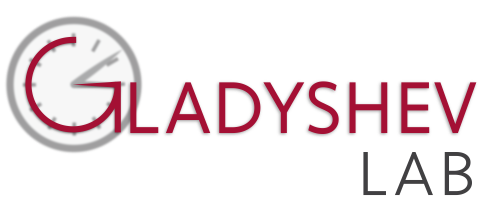2007 Articles
Yoo MH, Xu XM, Carlson BA, Patterson AD, Gladyshev VN, Hatfield DL. (2007) Targeting thioredoxin reductase 1 reduction in cancer cells inhibits self-sufficient growth and DNA replication. PLoS ONE 2, e1112, 1-7.
Merchant SS, Prochnik SE, Vallon O, Harris EH, Karpowicz SJ, Witman GB, Terry A, Salamov A, Fritz-Laylin LK, Marechal-Drouard L, Marshall WF, Qu LH, Nelson DR, Sanderfoot AA, Spalding MH, Kapitonov VV, Ren Q, Ferris P, Lindquist E, Shapiro H, Lucas SM, Grimwood J, Schmutz J, Cardol P, Cerutti H, Chanfreau G, Chen CL, Cognat V, Croft MT, Dent R, Dutcher S, Fernandez E, Fukuzawa H, Gonzalez-Ballester D, Gonzalez-Halphen D, Hallmann A, Hanikenne M, Hippler M, Inwood W, Jabbari K, Kalanon M, Kuras R, Lefebvre PA, Lemaire SD, Lobanov AV., Lohr M, Manuell A, Meier I, Mets L, Mittag M, Mittelmeier T, Moroney JV, Moseley J, Napoli C, Nedelcu AM, Niyogi K, Novoselov SV., Paulsen IT, Pazour G, Purton S, Ral JP, Riano-Pachon DM, Riekhof W, Rymarquis L, Schroda M, Stern D, Umen J, Willows R, Wilson N, Zimmer SL, Allmer J, Balk J, Bisova K, Chen CJ, Elias M, Gendler K, Hauser C, Lamb MR, Ledford H, Long JC, Minagawa J, Page MD, Pan J, Pootakham W, Roje S, Rose A, Stahlberg E, Terauchi AM, Yang P, Ball S, Bowler C, Dieckmann CL, Gladyshev VN., Green P, Jorgensen R, Mayfield S, Mueller-Roeber B, Rajamani S, Sayre RT, Brokstein P, Dubchak I, Goodstein D, Hornick L, Huang YW, Jhaveri J, Luo Y, Martinez D, Ngau WC, Otillar B, Poliakov A, Porter A, Szajkowski L, Werner G, Zhou K, Grigoriev IV, Rokhsar DS, Grossman AR. (2007) The Chlamydomonas genome reveals the evolution of key animal and plant functions. Science 318, 245-250.
More Information
More Information
More Information
Aachmann FL, Fomenko DE, Soragni A, Gladyshev VN, Dikiy A. (2007) Structural analysis of selenoprotein W and NMR analysis of its interaction with 14-3-3 proteins. J. Biol. Chem. 282, 37036-37044.
Kim HY, Gladyshev VN. (2007) Methionine sulfoxide reductases: selenoprotein forms and roles in antioxidant protein repair in mammals. Biochem. J. 407, 321-329.
Lobanov AV, Fomenko DE, Zhang Y, Sengupta A, Hatfield DL, Gladyshev VN. (2007) Evolutionary dynamics of eukaryotic selenoproteomes: large selenoproteomes may associate with aquatic and small with terrestrial life. Genome Biol. 8, R198.
Carlson BA, Moustafa ME, Sengupta A, Schweizer U, Shrimali R, Rao M, Zhong N, Wang S, Feigenbaum L, Lee BJ, Gladyshev VN, Hatfield DL. (2007) Selective restoration of the selenoprotein population in a mouse hepatocyte selenoproteinless background with different mutant selenocysteine tRNAs lacking Um34. J. Biol. Chem. 282, 32591-32602.
Xu XM, Carlson BA, Zhang Y, Mix H, Kryukov GV, Glass RS, Berry MJ, Gladyshev VN, Hatfield DL. (2007) New developments in selenium biochemistry: selenocysteine biosynthesis in eukaryotes and archaea. Biol. Trace Elem. Res. 119, 234-241.
Shchedrina VA, Novoselov SV, Malinouski MY, Gladyshev VN. (2007) Identification and characterization of a selenoprotein family containing a diselenide bond in a redox motif. Proc. Natl. Acad. Sci. USA 104, 13919-13924.
AbstractSelenocysteine (Sec, U) insertion into proteins is directed by translational recoding of specific UGA codons located upstream of a stem-loop structure known as Sec insertion sequence (SECIS) element. Selenoproteins with known functions are oxidoreductases containing a single redox-active Sec in their active sites. In this work, we identified a family of selenoproteins, designated SelL, containing two Sec separated by two other residues to form a UxxU motif. SelL proteins show an unusual occurrence, being present in diverse aquatic organisms, including fish, invertebrates, and marine bacteria. Both eukaryotic and bacterial SelL genes use single SECIS elements for insertion of two Sec. In eukaryotes, the SECIS is located in the 3′ UTR, whereas the bacterial SelL SECIS is within a coding region and positioned at a distance that supports the insertion of either of the two Sec or both of these residues. SelL proteins possess a thioredoxin-like fold wherein the UxxU motif corresponds to the catalytic CxxC motif in thioredoxins, suggesting a redox function of SelL proteins. Distantly related SelL-like proteins were also identified in a variety of organisms that had either one or both Sec replaced with Cys. Danio rerio SelL, transiently expressed in mammalian cells, incorporated two Sec and localized to the cytosol. In these cells, it occurred in an oxidized form and was not reducible by DTT. In a bacterial expression system, we directly demonstrated the formation of a diselenide bond between the two Sec, establishing it as the first diselenide bond found in a natural protein. More Information
Zhang Y, Gladyshev VN. (2007) High content of proteins containing 21st and 22nd amino acids, selenocysteine and pyrrolysine, in a symbiotic deltaproteobacterium of gutless worm Olavius algarvensis. Nucleic Acids Res. 35, 4952-4963.
AbstractSelenocysteine (Sec) and pyrrolysine (Pyl) are rare amino acids that are cotranslationally inserted into proteins and known as the 21st and 22nd amino acids in the genetic code. Sec and Pyl are encoded by UGA and UAG codons, respectively, which normally serve as stop signals. Herein, we report on unusually large selenoproteomes and pyrroproteomes in a symbiont metagenomic dataset of a marine gutless worm, Olavius algarvensis. We identified 99 selenoprotein genes that clustered into 30 families, including 17 new selenoprotein genes that belong to six families. In addition, several Pyl-containing proteins were identified in this dataset. Most selenoproteins and Pyl-containing proteins were present in a single deltaproteobacterium, delta1 symbiont, which contained the largest number of both selenoproteins and Pyl-containing proteins of any organism reported to date. Our data contrast with the previous observations that symbionts and host-associated bacteria either lose Sec utilization or possess a limited number of selenoproteins, and suggest that the environment in the gutless worm promotes Sec and Pyl utilization. Anaerobic conditions and consistent selenium supply might be the factors that support the use of amino acids that extend the genetic code. More Information
Sal LS, Aachmann FL, Kim H, Gladyshev VN, Dikiy A. (2007) NMR assignments of 1H, 13C and 15N spectra of methionine sulfoxide reductase B1 from Mus musculus. Biomol NMR Assign, 1, 131-133.
Su D, Berndt C, Fomenko DE, Holmgren A, Gladyshev VN. (2007) A Conserved cis-Proline Precludes Metal Binding by the Active Site Thiolates in Members of the Thioredoxin Family of Proteins. Biochemistry 46, 6903-6910.
Dikiy A, Novoselov SV, Fomenko DE, Sengupta A, Carlson BA, Cerny RL, Ginalski K, Grishin NV, Hatfield DL, Gladyshev VN. (2007) SelT, SelW, SelH, and Rdx12: Genomics and Molecular Insights into the Functions of Selenoproteins of a Novel Thioredoxin-like Family. Biochemistry 46, 6871-6882.
Novoselov SV, Lobanov AV, Hua D, Kasaikina MV, Hatfield DL, Gladyshev VN. (2007) A highly efficient form of the selenocysteine insertion sequence element in protozoan parasites and its use in mammalian cells. Proc. Natl. Acad. Sci. USA 104, 7857-7862.
Yoo MH, Xu XM, Turanov AA, Carlson BA, Gladyshev VN, Hatfield DL. (2007) A new strategy for assessing selenoprotein function: siRNA knockdown/knock-in targeting the 3′-UTR. RNA 13, 921-929.
Koc A, Gladyshev VN. (2007) Methionine sulfoxide reduction and the aging process. Ann. NY Acad. Sci. 1100, 383-386.
Labunskyy VM, Hatfield DL, Gladyshev VN. (2007) The Sep15 protein family: Roles in disulfide bond formation and quality control in the endoplasmic reticulum. IUBMB Life 59, 1-5.
Xu XM, Carlson BA, Irons R, Mix H, Zhong N, Gladyshev VN, Hatfield DL. (2007) Selenophosphate synthetase 2 is essential for selenoprotein biosynthesis. Biochem. J. 404, 115-20.
Novoselov SV, Kryukov GV, Xu XM, Carlson BA, Hatfield DL, Gladyshev VN. (2007) Selenoprotein H is a nucleolar thioredoxin-like protein with a unique expression pattern. J. Biol. Chem. 282,11960-11968.
Grossman AR, Croft M, Gladyshev VN, Merchant SS, Posewitz MC, Prochnik S, Spalding MH. (2007) Novel metabolism in Chlamydomonas through the lens of genomics. Curr. Opin. Plant Biol. 10, 190-198.
Fomenko DE, Xing W, Adair BM, Thomas DJ, Gladyshev VN. (2007) High-Throughput Identification of Catalytic Redox-Active Cysteine Residues. Science 315, 387-389.
Mix H, Lobanov AV, Gladyshev VN. (2007) SECIS elements in the coding regions of selenoprotein transcripts are functional in higher eukaryotes. Nucleic Acids Res. 35, 414-423.
Shrimali RK, Weaver JA, Miller GF, Starost MF, Carlson BA, Novoselov SV, Kumaraswamy E, Gladyshev VN, Hatfield DL. (2007) Neuromuscul. Disord. 7, 135-142.
Xu XM, Carlson BA, Mix H, Zhang Y, Saira K, Glass RS, Berry MJ, Gladyshev VN, Hatfield DL. (2007) Biosynthesis of Selenocysteine on Its tRNA in Eukaryotes. PLoS Biol. 5, e4, 1-9.



